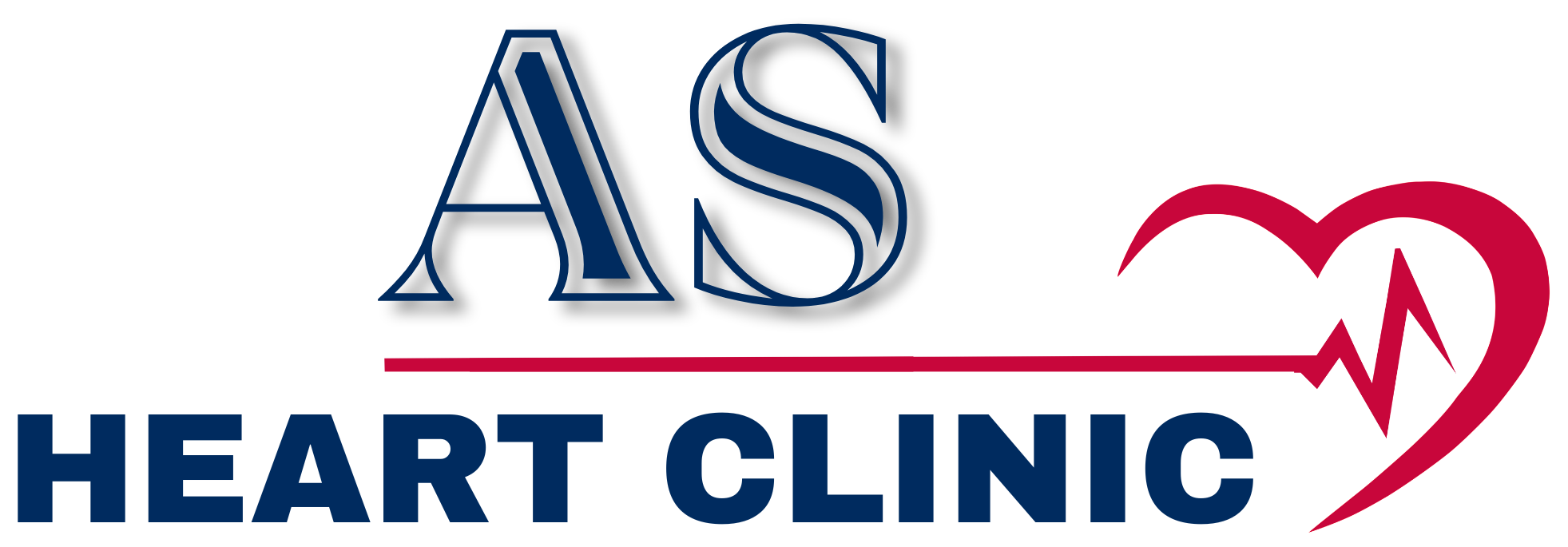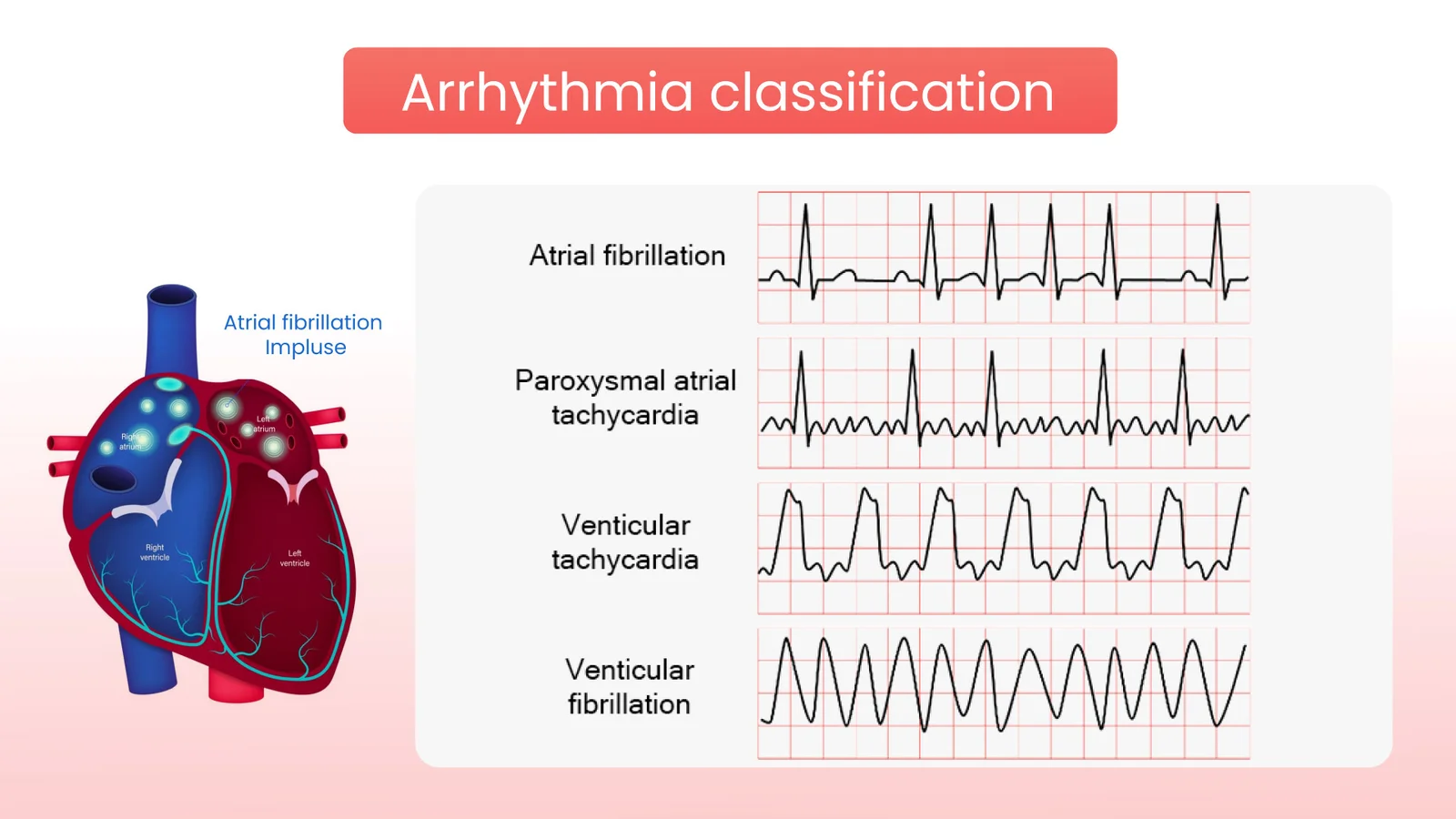Arrhythmias
Arrhythmias refer to abnormal heart rhythms, which occur when the electrical signals that coordinate heartbeats do not function properly. This can result in the heart beating too fast (tachycardia), too slow (bradycardia), or irregularly. Arrhythmias can affect how well the heart pumps blood, leading to a range of symptoms from harmless palpitations to life-threatening conditions such as stroke or cardiac arrest.
Types of Arrhythmias:
Atrial Fibrillation (AFib):
- Description: Atrial fibrillation is an irregular and often rapid heart rhythm originating in the atria (upper chambers of the heart). It causes poor blood flow and increases the risk of blood clots, stroke, and heart failure.
- Symptoms: Palpitations, shortness of breath, fatigue, dizziness, chest pain.
- Treatment Options: Medications (blood thinners, beta-blockers, antiarrhythmics), cardioversion (restoring normal heart rhythm), and catheter ablation (destroying abnormal heart tissue causing arrhythmia).
Atrial Flutter:
- Description: Atrial flutter is similar to atrial fibrillation but tends to be more organized and less chaotic. The atria beat rapidly, but the heart’s ventricles may still beat in a regular pattern. It can also lead to blood clots and stroke.
- Symptoms: Palpitations, fatigue, shortness of breath, dizziness.
- Treatment Options: Medications to control heart rate, catheter ablation, and anticoagulation therapy to prevent stroke.
Ventricular Tachycardia:
- Description: Ventricular tachycardia is a fast heart rhythm that starts in the ventricles (lower chambers of the heart). It is a potentially life-threatening condition, especially if it lasts more than a few seconds, as it can lead to ventricular fibrillation or cardiac arrest.
- Symptoms: Palpitations, chest pain, dizziness, fainting, shortness of breath.
- Treatment Options: Antiarrhythmic medications, implantable cardioverter-defibrillator (ICD), or catheter ablation.
Ventricular Fibrillation (VFib):
- Description: Ventricular fibrillation is a severe and life-threatening arrhythmia where the ventricles quiver ineffectively instead of pumping blood. This condition requires immediate medical intervention, as it can lead to cardiac arrest and sudden death.
- Symptoms: Loss of consciousness, lack of pulse, cardiac arrest.
- Treatment Options: Emergency defibrillation (shock to restore normal rhythm), followed by ICD implantation and medications to prevent recurrence.
Bradycardia:
- Description: Bradycardia occurs when the heart rate is slower than normal, typically fewer than 60 beats per minute. While bradycardia can be normal in well-conditioned athletes, it can also result from problems with the heart’s electrical system.
- Symptoms: Fatigue, dizziness, fainting, chest pain, confusion.
- Treatment Options: If symptomatic, a pacemaker may be implanted to regulate the heart’s rhythm.
Premature Heartbeats (PVCs/PACs):
- Description: Premature heartbeats occur when the heart has extra or early beats. Premature ventricular contractions (PVCs) originate in the ventricles, while premature atrial contractions (PACs) originate in the atria. These arrhythmias are usually harmless but can sometimes cause palpitations.
- Symptoms: Skipped heartbeats, fluttering sensation in the chest.
- Treatment Options: Often no treatment is needed, but reducing stress, caffeine, and tobacco can help. In some cases, medications or catheter ablation may be recommended.
Supraventricular Tachycardia (SVT):
- Description: SVT refers to an abnormally fast heart rhythm that originates above the ventricles, typically in the atria. The heart can beat over 100 times per minute during an episode.
- Symptoms: Sudden onset of rapid heartbeat, palpitations, dizziness, shortness of breath, and chest discomfort.
- Treatment Options: Vagal maneuvers (e.g., bearing down), medications, cardioversion, or catheter ablation to prevent future episodes.
Causes and Risk Factors:
- Heart Diseases: CAD, heart failure, or previous heart surgery can lead to arrhythmias.
- High Blood Pressure: Increases the risk of arrhythmias by causing the heart’s walls to thicken and disrupt normal electrical signals.
- Electrolyte Imbalance: Imbalances in potassium, sodium, calcium, or magnesium levels can affect the heart’s electrical signals.
- Thyroid Disorders: An overactive or underactive thyroid can influence heart rhythms.
- Medications: Certain drugs, such as stimulants, beta-blockers, or antiarrhythmic medications, can cause arrhythmias.
- Alcohol and Caffeine: Excessive intake can trigger arrhythmias, especially in susceptible individuals.
- Stress: Physical or emotional stress can trigger arrhythmias, particularly in individuals with underlying heart conditions.
Symptoms of Arrhythmias:
- Palpitations (feeling of a racing or irregular heartbeat)
- Shortness of breath
- Dizziness or lightheadedness
- Chest pain or discomfort
- Fainting (syncope) or near fainting
- Fatigue or weakness
- Anxiety
Diagnosis of Arrhythmias:
- Electrocardiogram (ECG): A common test that records the heart’s electrical activity and helps identify abnormal rhythms.
- Holter Monitor: A portable ECG worn for 24-48 hours to capture arrhythmias that may not occur during a standard ECG.
- Event Monitor: A device worn for several weeks to detect intermittent arrhythmias.
- Echocardiogram: An ultrasound test to check for structural problems in the heart that could cause arrhythmias.
- Electrophysiological Study (EPS): A more invasive test where a catheter is used to map the heart’s electrical system and pinpoint the source of arrhythmias.
Treatment Options:
Medications:
- Antiarrhythmics: Used to restore or maintain a normal heart rhythm.
- Beta-Blockers: Slow down the heart rate and reduce palpitations.
- Calcium Channel Blockers: Help control the heart rate in conditions like atrial fibrillation.
- Anticoagulants (Blood Thinners): Reduce the risk of stroke in patients with atrial fibrillation.
Catheter Ablation:
- A minimally invasive procedure where small areas of heart tissue causing abnormal rhythms are destroyed using heat or cold energy.
Pacemaker:
- A device implanted to regulate slow heart rhythms (bradycardia) by sending electrical pulses to the heart to maintain a normal rate.
Implantable Cardioverter-Defibrillator (ICD):
- A device similar to a pacemaker that monitors heart rhythms and delivers shocks to restore normal rhythm in life-threatening arrhythmias like ventricular fibrillation or tachycardia.
Cardioversion:
- A procedure using electrical shocks or medications to reset the heart’s rhythm to normal, often used in atrial fibrillation or flutter.
Prevention:
- Healthy Diet: A heart-healthy diet low in sodium, unhealthy fats, and sugars can help reduce the risk of arrhythmias.
- Regular Exercise: Engaging in moderate exercise can improve heart health and reduce arrhythmia risk.
- Avoid Excessive Alcohol and Caffeine: Reducing intake can prevent episodes of arrhythmias.
- Manage Stress: Stress-relief techniques like meditation, yoga, and deep breathing exercises can help prevent arrhythmias.
- Quit Smoking: Smoking can damage the heart and increase the likelihood of arrhythmias.
Arrhythmias can range from benign to life-threatening, and early diagnosis and treatment are crucial in preventing serious complications.


